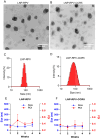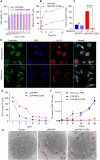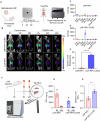This is a preprint.
CCR5 Decorated Rilpivirine Lipid Nanoparticles Build Myeloid Drug Depots Which Sustains Antiretroviral Activities
- PMID: 38883780
- PMCID: PMC11177988
- DOI: 10.21203/rs.3.rs-4433306/v1
CCR5 Decorated Rilpivirine Lipid Nanoparticles Build Myeloid Drug Depots Which Sustains Antiretroviral Activities
Update in
-
CCR5-ligand decorated rilpivirine lipid-based nanoparticles for sustained antiretroviral responses.Nat Commun. 2025 Jan 8;16(1):513. doi: 10.1038/s41467-024-55544-9. Nat Commun. 2025. PMID: 39779664 Free PMC article.
Abstract
Antiretroviral therapy (ART) improves the quality of life for those living with the human immunodeficiency virus type one (HIV-1). However, poor compliance reduces ART effectiveness and leads to immune compromise, viral mutations, and disease co-morbidities. A novel drug formulation is made whereby a lipid nanoparticle (LNP) carrying rilpivirine (RPV) is decorated with the C-C chemokine receptor type 5 (CCR5). This facilitates myeloid drug depot deposition. Particle delivery to viral reservoirs is tracked by positron emission tomography. The CCR5-mediated RPV LNP cell uptake and retention reduce HIV-1 replication in human monocyte-derived macrophages and infected humanized mice. Focused ultrasound allows the decorated LNP to penetrate the blood-brain barrier and reach brain myeloid cells. These findings offer a role for CCR5-targeted therapeutics in antiretroviral delivery to optimize HIV suppression.
Keywords: CCR5-targeting; HIV; antiretroviral therapy; lipid nanoparticles; non-invasive imaging.
Conflict of interest statement
Additional Declarations: Yes there is potential Competing Interest. Howard Gendelman is the co-founder of Exavir Therapeutics, Inc, a company formed to develop LA ART.
Figures






References
-
- Fotooh Abadi L, Kumar P, Paknikar K, Gajbhiye V, Kulkarni S (2023) Tenofovir-tethered gold nanoparticles as a novel multifunctional long-acting anti-HIV therapy to overcome deficient drug delivery-: an in vivo proof of concept. J Nanobiotechnol 21(1):19. 10.1186/s12951-022-01750-wFrom NLM - DOI - PMC - PubMed
Publication types
Grants and funding
LinkOut - more resources
Full Text Sources

